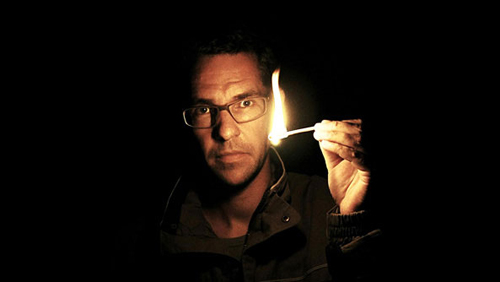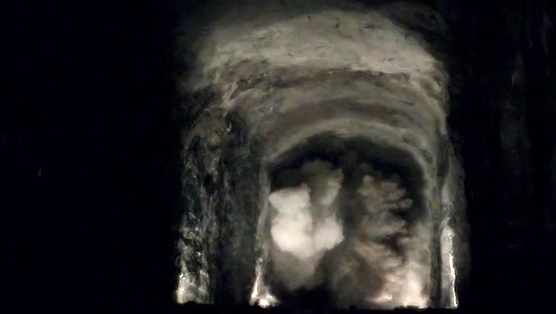what is really going on here?
Onkalo - Into Eternity
Complete, annotated transcript of Maria Gilardin's introduction to the film
broadcast on
TUC Radio, 12 July 2011
The Journey Our Nuclear Waste Must Make: Into Eternity
Complete, annotated transcript of the interview with film-maker Michael Madsen,
Writer and Director of Into Eternity, conducted by Dr. Helen Caldicott
If You Love This Planet,
15 July 2011
Fukushima Into Eternity statement by Michael Madsen, March 2012

|
“Onkalo is our very first permanent repository for
nuclear waste. But when Onkalo is sealed a century from
now, it'll hold only a fraction of the waste we have. We must
build many more Onkalos far from earthquakes and volcanoes
to keep the waste away from the surface of the earth. We
must build many more secret chambers that we hope to hide
from you.”
—Michael Madsen: Writer, Director, Narrator, Into Eternity
|
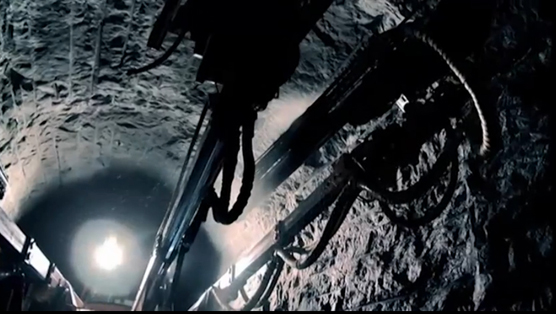
Into Eternity © Magic Hour Films
|
The problem is, of course – and this is a problem that will encompass
every such a facility – is that, in Finland the arguement is that,
‘We can put it in the bedrock because the bedrock has been stable for
such-and-such a long time. And therefore it will also be stable in the
future.’ But it is not a scientific arguement to say that because the
past looked like that, so will the future look like that.
That's
what the whole thing rests upon in Finland and in any such a repository
in the world wherever they may be built. But the problem is – and it is
one of the paradoxes involved in trying to handle nuclear waste responsibly
towards the future generations – the problem is that we have nothing to
compare with and we have no way for testing if it will work simply because the
time span is so big. That is the real problem.
|
Credits
PRODUCTION
Director and Scriptwriter Michael Madsen
Producer Lise Lense-Møller
Editors Daniel Dencik, Stefan Sundlöf
Director of PHOTOGRAPY Heikki Färm F.S.C.
Sound Design Nicolai Linck, Øivind Weingaarde
Mix Tomas Arwe
PRODUCER
Magic Hour Films
CO-PRODUCERS
Mouka Filmi Sami Jahnukainen, Finland
ATMO Kristina Åberg & Lisa Taube, Sweden
Film i
Väst Tomas Eskilsson, Sweden
CO-FINANCIERS
Minerva Film, Denmark
MASSPRODUCTION, Denmark
WITH THE SUPPORT FROM
Danish Film Institute by film commissioners
Dola Bonfils and Jesper Jack
EURIMAGES
The Swedish Film Institute Lisa Ohlin
Finnish Film Foundation Elina Kivihalme
Nordic Film & TV Fund Karolina Lidin, Lise Løwholm
AVEK – The Promotional Center for Audiovisual Culture Ulla Simonen
Sonning Fonden
Politiken Fonden
Danish Film Directors
SVT Stockholm / CULTURE Hjalmar Palmgren
YLE Co-Productions Outi Saarikoski
WORLD SALES
Films Transit International Diana Holtzberg and Jan Rofekamp
ADDITIONAL
3D Corporate animations by
Montaasi Media Oy
WEBSITE
intoeternitythemovie.com
|
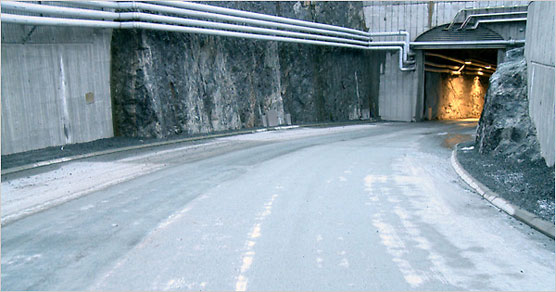
Into Eternity © Magic Hour Films
|
|
Helen Caldicott:
|
I think the Americans choose a million years
[for nuclear waste to be isolated from the environment] because
when you think about it plutonium has a half-life of
24,400 years. Some people multiply that by 10 to
get the total radiological life. But some multiply
it by 20 which brings you up to half a million
years. And then you see radioactive iodine-129
has a half-life of 17 million years. There are
quite a few isotopes that have extremely long
half-lives. So I suppose to encompass the whole
gradient of radioactive elements, and as you said
almost every element is made in a reactor, they
would put the number at a million. But it would
be interesting, wouldn't it Michael, to research
why the Americans have chosen a million years.
|
Michael Madsen:
|
Yes, but when I asked the scientists in Finland
I received two kinds of answers within the same
company. The communication manager said,
‘Michael, you have to understand that
high level nuclear waste becomes less and
less toxic because of the half-life. So really
Michael it's all the time diminishing the
problem, from day to day.’
Then the head expert of the long-term safety
[group] said, ‘Michael, I do not agree
with this way of talking about high level
nuclear waste because essentially, when we
are talking about these time spans, it is
forever. In the human time scale it's
forever.’ . . . To talk about
a hundred thousand years or a million years
doesn't really make sense. What we have to
think about is that it is about a hundred
thousand years [ago] that homo sapiens left
Africa for the first time. That is what
we're talking about.
|
|
Cast
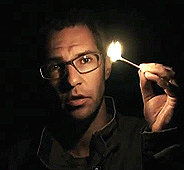
Into Eternity © Magic Hour Films
MICHAEL MADSEN
FILM DIRECTOR
|
|
“We recognize that this could happen. That you might find and open
Onkalo. We refer to that as human intrusion. We don't want this to happen
because you may get hurt. But most of all we are afraid of human intrusion
because if Onkalo is opened the waste will no longer be isolated from all
living organisms and we will have failed. In fact, we consider you the
main threat to the safety of Onkalo.”
“When the burial chamber was complete, man laid his new fire to rest
and tried to forget about it. For he knew that only through oblivion would
he be free from it. But then he started to worry that his children might
find the burial chamber and awaken the fire from its sleep. So he bade his
children to tell their children, and their children's children too, to remember
forever to consign the burial chamber to oblivion. To remember forever to forget.
”
|
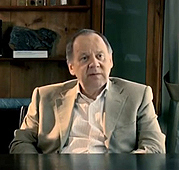
Into Eternity © Magic Hour Films
TIMO ÄIKÄS
|
|
“I think that more and more societies in countries
who are using nuclear power are realizing that
they also have to do something.”
Q: “If you were a person who were evaluating this concept
from the outside, what would you be afraid of?”
TÄ: [Pause] “Nothing.”
Q: “What if someone finds the repository? How should
they know what it is?”
TÄ: “They should have some measuring tools to
measure the radiation.”
Q: “What if they don't have that?”
TÄ: “Well then they have to make a chemical analysis [nervous laugh].”
Q: “What if they can't do that?”
TÄ: “Well if they cannot do that they cannot do the drilling either.”
“The design and the construction and implementation has to be done so
that no knowledge is necessary for the future. So that it can be safe also
in that case that people would have lost the knowledge.”
|
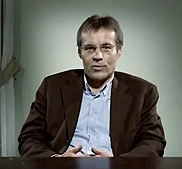
Into Eternity © Magic Hour Films
TIMO SEPPÄLÄ
|
|
Q: “How much waste exists in the world today, totally?”:
TS: “I'm not quite aware. I would say between 200,000 and
300,000 tonnes. Somewhere between these two.”:
“We have come to a conclusion that the bedrock, the Finnish
bedrock, 1.8 billion years old, is the medium that we
can predict, far to the future, at least 100,000 years
ahead.”:
“Final disposal of spent nuclear fuel hasn't been implemented
anywhere so far. We are kind of forerunners in this field. And we
are dealing with very, very long time frames. Meaning that this
repository should last at least 100,000 years.”
“My personal belief is that no human intrusion will take place at any
time scale, ever.”
|
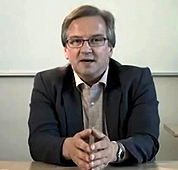
Into Eternity © Magic Hour Films
JUHANI VIRA
|
|
Q: “[STUK is required to pass on the information about the repository] In
a permanent manner, that's the exact phrasing. What do you think they mean by that?”
JV: “Yes, I think you should ask them. Because we've just talked
about the problems of that. Permanent is too strong a word to be used here.”
“We are trying to do Onkalo as independent of human nature as
possible because we can't predict exactly how the humans will behave in the
future.
”
|
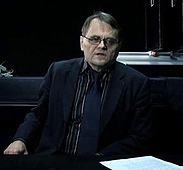
Into Eternity © Magic Hour Films
ESKO RUOKOLA
|
|
“Some of the main principles included in the legislation are:
Firstly, the limitation of burdens on future generations. . . .
Second principle is protection of future generations. That means that
safety level it should be afforded for future generations to not be lower than
it is so currently.
And then Third principle is that we should pass information about the
repository to future generations.”
Q: “So the idea is that the archive of today should last for a certain
period but then be renewed by the next generation.”
ER: “Yes. Each generation should consider it, [that] the archiving
method is appropriate for the future.”
Q: “Do you think this will happen?”
ER: “Yah I hope so, at least [nervous laugh]”
|
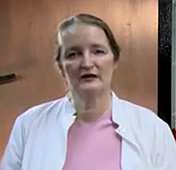
Into Eternity © Magic Hour Films
WENDLA PAILE
|
|
“A hundred years ago, just three human generations ago when radiation
was first discovered, we didn't understand that it was very dangerous. But we
noticed that it can be useful and we started to work with it. Radiation is a
sort of energy which can penetrate deep into your body and harm your health.
But it is an invisible danger. We have no sense for it. You cannot see it,
feel it, or smell it. And still it may even kill you. Radiation then can be described
as small packages of energy and when they hit the genetic code, the DNA molecule,
they can break it, split it. . . . Radiation can also leave a trace in you. It
can change the genes, mutate the genes. It will cause malformation or disease or
dysfunction.”
|
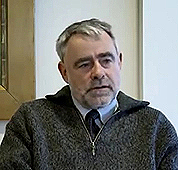
Into Eternity © Magic Hour Films
MIKAEL JENSEN
|
|
“We must realize that the future scenarios are not just about high
tech or very low tech, like a stone-age scenario. We have scenarios in the middle
where people may drill but they may not understand, they may not have the
technology to understand what they meet.”
“You have the scenario of the hidden treasure. You have the idea that
something is there and it is valuable and people would start to dig for it.
You could even have the scenario where people even know it is dangerous
but it is also valuable at the same time.”
Q: “And what about the people who work with these
things?” [1]
MJ: “They get the ‘scientific disease’ so to say. It's all
routine for them. They have the task.”
Q: “I don't really understand it, I think.”
MJ: “No I don't think anybody does.”
“When you do a project like this, you must state what you
know, and you must state that you know what you know that you don't know,
and also what you don't know that you don't know.”
|

Into Eternity © Magic Hour Films
BERIT LUNDQVIST
|
|
“I think if someone found a facility like that [Onkalo] in the future
they might interpret it as something religious: a burial ground. Or a
treasure.”
BL: “I'm not so sure that nuclear energy is the solution. Maybe in the short time (this
is my personal view too); I don't think it's sustainable in the long run. But maybe
for the next decades, century.”
Q: “Why do you think so?”
BL: “Because we won't have enough uranium. It will be just like the oil.”
|
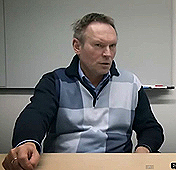
Into Eternity © Magic Hour Films
PETER WIKBERG
|
|
“We would never be able to claim that we can safely put something
into the bottom of the oceans. Because still we have an impression that
the oceans are really the mother of all life. It is not a safe
way of handling spent nuclear fuel or radioactive waste.”
“What we must do, is to take care of the waste from
the nuclear power plants.”
“That's what we really want to prove: that we can
isolate the waste from human beings and other life
organisms for 100,000 years.”
“We obtained the energy. We have used the energy. Of
course it's our mission to also take care of the waste.”
“Keeping the waste in tanks is probably possible
for the next 10 years, 20 years, 100 years,
1,000 years.”
|
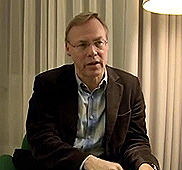
Into Eternity © Magic Hour Films
CARL REINHOLD BRÅKENHIELM
|
|
“This is something which ought to be the responsibility of all citizens,
irrespective of whether they like nuclear power or not. Linking the issue of
nuclear waste with nuclear power could easily divert attention from the
material which we have and must somehow handle in a responsible way: not to
harm future generations.”
“And the Roman Empire was born, lived, prospered, and died. And similarly
also the West will go through the same kind of phases: being born, flourishing,
developing, crumbling, and dying. What do we know about society in 300 years?
Virtually impossible to say anything. We might expect society as we know it to
exist for 50 years more, or for a hundred years. And if you are convinced of
what will happen then, lets put the question on a 300 years, 500 years time. Then
the darkness thickens.“
|
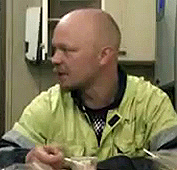
Into Eternity © Magic Hour Films
SAMI SAVONRINNE,
|
|
Q: “Where are you now on the plan?”
SS: “Should be here somewhere.” [pointing to a map diagram]
SS: “Then we start widening this area. More and more and more bigger
area come.”
Q: “Like in a big cave or ... ”
SS: “Yeah. An unimaginable big cave. It's like a
big city underground.”
|
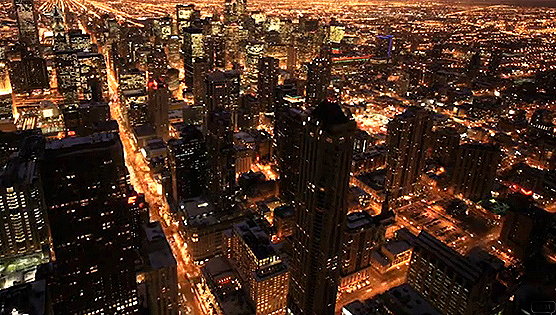
Into Eternity © Magic Hour Films
|
|
“My civilization depends on energy as no civilization
before us. Energy is the main currency for us. Is it
the same for you? Does your way of life also depend
on unlimited energy?”
—Michael Madsen: Writer, Director, Narrator, Into Eternity
|
|
